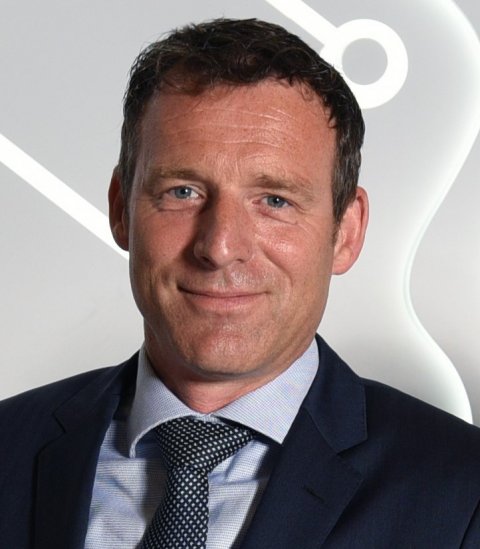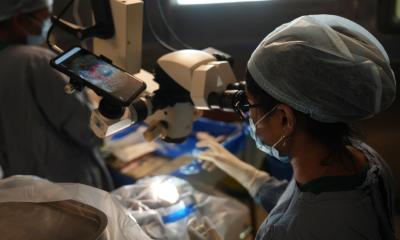Image source: Asensus Surgical Inc.
Article • Surgical robotics
Elevating outcomes of surgery
What’s in a name? In the case of Asensus Surgical, Inc., previously known as TransEnterix, Inc., the recent rebranding doubles as a mission statement for the manufacturer of surgical robotics systems: The initial ‘A’ stands for artificial intelligence and augmented surgery, reflecting the company’s emphasis on new technologies designed to enhance the operator’s cognition (‘sensus’ in Latin).
We spoke with Wouter Donders, General Manager EMEA / CIS at Asensus Surgical, about the integration of the newest Augmented Intelligence technologies being introduced in surgery now in Germany, their applications in robotic surgery, and a new training partnership with Amsterdam Skills Centre to help surgeons elevate their skill with these new possibilities.
Why the Elevation of Surgical Outcomes is needed:

Image source: Asensus Surgical Inc.
1 in 5 patients undergoing surgery has 1 or more complications. “This is simply not good practice if you compare this with other industries. Think what this would mean if you had these complications in the airline industry, no company would survive,” says Mr. Donders.
Surgeons and hospitals are committed to delivering the best patient outcomes possible – every time. But the operating room (OR) is an atmosphere conducive to unpredictable outcomes, costs, and inefficiencies. Consistent results are challenging to achieve when surgeries are performed with dated technology by different people with different levels of skill, experience, and training.
The Asensus Surgical Assurance Framework is at the heart of this digital interface, ensuring surgeons have advanced point-of-care knowledge to elevate their performance throughout every stage of surgery. This is Performance-Guided Surgery™. This type of surgery addresses each phase of the surgical decision chain to increase safety for better outcomes which leads to improved patient and provider satisfaction. Additionally, it reduces surgical variability, factors that contribute to poor outcomes. This real-time Clinical Intelligence and capabilities will create more consistent, predictable outcomes.
Asensus Surgical Partnership with the Amsterdam Skills Centre (ASC) in the Netherlands

Image source: Asensus Surgical Inc.
To teach surgeons the necessary skills to handle technically advanced systems, Asensus has entered a partnership with the Amsterdam Skills Centre (ASC) in the Netherlands. “When we sell one of our systems to a hospital, training is part of the product offering,” says Donders. “Surgeons have to attain certification to operate the Senhance® Surgical System. Together with the ASC and Asensus team, we train surgeons how to do their daily surgery with our Senhance robot.” In a 3-day course, participants learn how to use the robotic system and familiarise themselves with the advanced features through dry lab training and practice on human cadavers. “The ASC is a brand new top-of-the-range institution under the guidance of the UMC Amsterdam clinics, so we are really happy about this cooperation,” added Donders.
Eye-tracking, haptic feedback, augmented 3D HD visualisation, 3 mm instruments – the Senhance Surgical System is literally packed with innovative technologies to be better prepared for the surgery with intelligent dashboard settings, giving surgeons perceptive real-time guidance during surgery and supporting the surgeon after surgery via performance analytics.
Recommended article

Article • Senhance® Surgical Robotic System
„Robotic systems are the future of medicine“
In April 2017, St. Marien Hospital in Siegen, Germany, made robotic history: it was the first hospital in Germany to introduce the Transenterix surgical robotic system. Since then, more than 450 surgeries were performed with the Senhance® surgical robotic system and the expertise of Professor Dr Dietmar Stephan, Head of Minimally Invasive Surgery, is in high demand – worldwide.
One of the systems’ intricacies that surgeons get acquainted with is the eye-tracking feature, which allows control of the laparoscope just by looking at where the instrument should move or where the surgeon is focusing. The system centers on any point that the surgeon’s eyes focus on, eliminating the need to adjust the view via a joystick. The eyes of the surgeon are becoming the 3rd hand in surgery and are even tracking for analytic purposes. Additional sensors keep track of the equipment position during the procedure, so the surgeon knows where the instruments are. These tools pave the way to what Donders calls ‘performance-guided surgery’. “What this means is that the system supports and elevates the surgical skill of the operator, leading to increased control, less variability and consistently superior outcomes,” commented Donders.
In the Skills Centre, surgeons can perform basic procedures that highlight the benefits of the Senhance Surgical System in combination with techniques like indocyanine green (ICG) fluorescence imaging. Customers interested in using the system in their hospital can also request a demonstration at the ASC to gather first-hand impressions.
Senhance Connect: Bringing Surgical Peers Together
The system also helps with remote support—a feature that has become increasingly important during the COVID-19 pandemic, says Donders. “We are launching a telemonitoring system called ‘Senhance Connect’ in April, where surgical peers from around the world are able to remotely observe a Senhance case via cameras and communicate with an expert Senhance surgeon about the most advantageous practices. For example, a surgeon can benefit from the expertise of a colleague who specialises in a certain operation.”
The Future of Surgery: Machine Vision, Augment Intelligence and Deep Learning
Machine vision, augmented intelligence and deep learning capabilities are the future in surgery, we call it ‘surgical intelligence’ – a smart assistant that facilitates procedures: “For example, the surgeon can tell the camera to follow the movement of his dominant hand, so that he does not have to adjust the view manually,” Donders elaborates. A recent pilot study in Germany has yielded promising results and some of the features have already been validated for use in Europe and the US, so the General Manager is confident that the first of these smart surgical helpers will enter clinical practice as soon as the second half of 2021.
Paediatric Surgery: ‘Robot Scepticism’ Is a Thing of the Past

Image source: Asensus Surgical Inc.
Advances in instrument manufacturing have opened up the field of paediatric surgery for the Senhance Surgical System. “We can now go as small as 3 mm, which makes it possible to operate in very small cavities – a common challenge in paediatric cases,” says Donders. After successful feasibility studies and clinical start in October 2020, the company now announces a new milestone: the world’s first paediatric renal pelvic surgery, which was performed with 3 mm instruments in February 2021. “We are very pleased with the enormous advances we made in this field so far,” the General Manager adds. “Our system has been given the indication for use in soft tissue from the mediastinum to the lower pelvis floor in paediatric patients with a bodyweight over 10 kg – which is about the average for a 1-year-old child.”
Actually, many parents even favour robotic surgery for their children if given the option
Wouter Donders
Due to their small size, paediatric patients benefit especially from the increased instrument stability offered by robotics, for example in reconstructive procedures. In Donders’ experience, this is something many parents are well aware of. “There used to be a certain scepticism towards robot-assisted interventions in the past, but this is no longer the case, Actually, many parents even favour robotic surgery for their children if given the option,” said Donders. The system provides surgeons with haptic feedback and force control to mitigate damage to delicate tissue.
With a rough estimate of complications happening in 20% of all surgeries, the company aims to support surgeons in dealing with these unpredictable events. Donders comments: “We want to provide assistance to the surgeon pre-, post-, and during surgery – more detailed insight, better spatial orientation, improved ergonomics and decision support.”
09.04.2021










